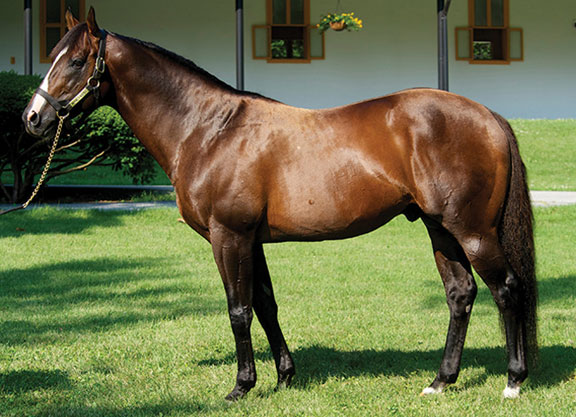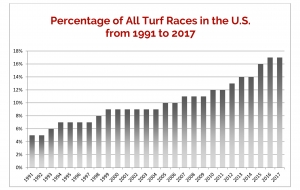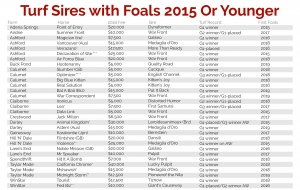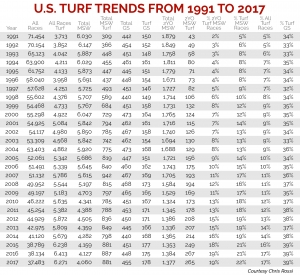By Sid Fernando
In 1991, only 5% of all flat races in the United States were on turf. By last year, that figure had risen to 17%. The incremental increase of turf racing over the past 27 years is vivid in the accompanying graph, which was extrapolated from racing data provided by researcher Chris Rossi (See below). This trend to turf is even more significant than the data suggests because in 2017 there were almost 50% fewer races than in 1991. The net effect is that turf racing is playing a greater role in the sport as the industry shrinks. Throw in that 39% of graded races in America were contested on turf in 2017, and you get the picture.
Stud farms in Kentucky have been adjusting to the change. In 2018, 14 Kentucky nurseries are offering 30 stallions that either won or placed in Grade I turf races (plus one, Violence, who was a Grade I winner on all-weather) with first foals age three or younger (See Chart below). That's a revelation, but it's not unexpected, because the trend line in the Rossi data suggests that turf racing will continue to grow in the ensuing years. Note that the Breeders' Cup recently announced that its newest race is a $1-million sprint on turf for juveniles.
“Well, there was a prejudice against turf sires at one point,” said Pope McLean Sr. of Crestwood Farm, which stands the War Front horse Jack Milton. “For a while, people just didn't want to touch them, but recently, with Kitten's Joy and others like War Front, and even a horse like Artie Schiller, breaking barriers, things are changing. We were pretty pleased to get 100-plus mares to Jack Milton in his first year, and they seem to have caught on at the sales, too.”
Back in 1991, Walmac International's Nureyev led all U.S.-based sires by yearling average and Claiborne Farm's Danzig led the North American General Sire List. Both sons of Northern Dancer were outstanding turf sires and were favorites of European buyers, just as Danzig's son War Front, also at Claiborne, is today. But Nureyev and Danzig operated in a different landscape than do War Front and Kitten's Joy. For example, when Kitten's Joy led the General Sire List in 2013, he did so primarily with domestic turf and all-weather horses that had more opportunities beyond dirt than ever before; in 1991, Danzig needed significant main-track runners–like Dance Smartly, the Canadian Triple Crown and Breeders' Cup Distaff winner that season, when she was also named Horse of the Year in Canada and champion 3-year-old filly in the U.S.–to land the sire championship.
Versatility
“I think what everyone wants, if possible, is a versatile horse that can get both dirt and turf,” said Duncan Taylor of Taylor Made Farm, which stands three young stallions in California Chrome, Mshawish, and Midnight Storm that were successful on the two surfaces. “We were lucky we got horses that could run on both, and we like that they could run on both, but we didn't go out consciously looking for turf. We got the best horses we could find. But we think people want a versatile horse.”
That versatility was best exemplified in 2017 by Darley's Medaglia d'Oro, the sire of Mshawish–who won the GI Gulfstream Park Turf H. at five and the GI Donn H. on dirt at six. Like Kitten's Joy and Artie Schiller, Medaglia d'Oro is a son of the imported El Prado (Ire), a European-raced son of Sadler's Wells. El Prado was the first son of Sadler's Wells whose progeny transitioned to dirt in the U.S., and Medaglia d'Oro, himself a dirt horse, has continued the duality that El Prado established as a sire of dirt and turf horses. At the Breeders' Cup, for instance, he was represented by Talismanic, winner of the GI Turf, and Bar of Gold, first in the GI Filly and Mare Sprint. In short, he gets 2-year-olds, classic horses, and older runners, and they act on all surfaces. He's the model of versatility at the top end of the market and as such his sons–even some foreign-bred ones–are getting their chances at stud in Kentucky.
John Sikura of Hill 'n' Dale launched Medaglia d'Oro's stud career and stands two of his sons, including Violence, one of the top freshman sires last year and currently the leading North American-based second-crop sire. Like Mshawish, Violence was a dual-surface runner, though he won his Grade I on the all-weather at two in the CashCall Futurity. He also won the GII Nashua on dirt. His first 3-year-olds are highly anticipated this year and are already off to a fast start.
Darley, which now stands Medaglia d'Oro, and Coolmore's Ashford Stud are each offering an Australian-bred son of Medaglia d'Oro. Darley's Astern is in his first season, and Ashford's champion 2-year-old Vancouver is serving his second book in the United States. Both are reverse shuttlers from Australia that were fast sprinters and raced exclusively on turf, but because of their sire's versatility they could conceivably be effective on dirt as well. However, they will have a larger turf environment to help their causes and that makes them even more appealing.
“We've always looked to find horses that are versatile and that we think will suit the American market,” said Dermot Ryan, manager of Ashford. “If you look through the years, there have been many European imports or horses that performed on turf that have become hugely successful while standing in Kentucky. People like Bull Hancock, John Gaines, and Johnny Jones stood many successful stallions that way and the same has been true for us at Ashford. Going as far back as Storm Bird and more recently Giant's Causeway and Scat Daddy, they have been integral parts of our stallion roster that owe a lot of their popularity to turf racing. Giant's Causeway has been champion sire three times with a combination of top dirt and turf horses and Scat Daddy, even though he only ran on dirt, has created a legacy on the world stage. Look at what the likes of Scat Daddy and War Front have done for the recent yearling sales results with the international participation they have attracted.”
The Turf Horse
Historically, as Ryan noted, turf horses have played a pivotal role in the development of American dirt horses, and you don't have to go far back over time to some of the great imports, horses like Sir Gallahad III in the 1920s, Blenheim II in the 1930s, Mahmoud in the 1940s, Nasrullah in the 1950s, or Ribot in the 1960s, to see the benefits. For example, Unbridled's Song, the sire of recent champions Arrogate and Forever Unbridled, was produced from a mare by Caro, as was Maria's Mon, sire of two Kentucky Derby winners. Caro, who sired Kentucky Derby winner Winning Colors, was imported by Spendthrift in the late 1970s. Unbridled, the sire of Unbridled's Song, was from a mare by Le Fabuleux, who was imported by Claiborne in the early 1970s. The same holds true for turf horses bred in North America. Take Nijinsky II, the 1970 English Triple Crown winner, who got Kentucky Derby winner Ferdinand. In the 1980s, Storm Bird, who raced entirely on turf in Europe, got one of our greatest dirt sires, Storm Cat, who in turn sired his share of turf horses in Giant's Causeway and Bernstein, among others.
More recently, Barry Irwin's Team Valor bred the Kentucky Derby winner Animal Kingdom by sending a German-bred mare to a Brazilian-bred stallion, Leroidesanimaux–the champion turf horse of 2005. Leroidesanimaux was by Candy Stripes, who was a son of Gainesway's top-class European import Blushing Groom. Animal Kingdom, now at stud at Darley, did well with his first juveniles last year, and his 3-year-olds figure to be even better. So far, his offspring are showing promise on turf and all-weather, and the horse could be the conduit for reigniting the Blushing Groom line here–if that happens, he can thank the increased turf opportunities for his offspring.
Blushing Groom, along with such stallions as Riverman, Irish River, Green Dancer, Melyno, and L'Emigrant, was one of several French Guineas winners that stood for John Gaines at Gainesway in the 1970s and 1980s, and it's notable that modern-day Gainesway, under the leadership of Antony Beck, has another French Guineas winner on its roster, Flaxman's Karakontie–a Bernstein horse bred in Japan.
Michael Hernon, director of sales at Gaineway, said the horse has been well received and has the backing of Beck and Flaxman, who, he pointed out, is supporting the horse in the sales arena, too. “There's a lot of money to be won on turf,” Hernon said, “and he seems to be a natural fit for that. Gainesway has had a successful history with turf horses, and this horse was fast and precocious, a Group 1 winner at two, a French Guineas winner at three, had tremendous acceleration, and he won the G1 Breeders' Cup Mile. People liked his foals.”
The international turf revolution was begun in the 1970s by E.P. Taylor's Kentucky Derby winner Northern Dancer, whose notable sons included Nijinsky II, Danzig, Nureyev, Sadler's Wells, Lyphard, and Storm Bird. Twenty of the 31 stallions in the accompanying chart trace in tail-male to him, mostly through Sadler's Wells and Danzig.
The cross of Sadler's Wells and Danzig–both ways–has been tremendously successful, especially in Europe, and is the main expression of Northern Dancer nowadays. Frankel, bred and raced by Juddmonte and a son of super sire Galileo, is the great example of Sadler's Wells over Danzig, as is his brother Noble Mission at Lane's End and Magician, also by Galileo, at Ashford. Hill 'n' Dale's Flintshire, the 2016 turf champion also bred and raced by Juddmonte, is a product of the reverse cross: he's by Dansili from a Sadler's Wells mare. Flintshire's pedigree also has inbreeding to Nijinsky through the latter's son Ile de Bourbon. It's a pedigree laden with Northern Dancer and with stamina, and Flintshire ran true to form as a 12-furlong turf performer.
Sikura stands the 2004 turf champion Kitten's Joy at Hill 'n' Dale, and it's fair to say that he's hoping for similar results with Flintshire, whose ownership group includes Juddmonte, SF Bloodstock and China Horse Club. It's a partnership that believes the U.S. can once again breed top-class international turf horses, but with the added turf opportunity here–which Kitten's Joy has exploited and serves as a model to follow–the risks of standing a 12-furlong turf horse in the U.S. are not as foreboding as they were a decade or so ago when Ken Ramsey started off Kitten's Joy–foolhardily, some said at the time.
“There is an evolving trend in North America that recognizes the purse opportunities of turf sires, turf offspring,” Sikura said. “And hopefully a recognition of worldwide currency that the turf horse is held in the highest regard. We've de-evolved from producing world-class turf horses the last 10 to 20 years and given that market share to other countries.”
Sikura said he's trying to fill the void with horses like Flintshire and Kitten's Joy, who after 12 seasons at Ramsey Farm is in his first year at Hill 'n' Dale in 2018 and getting an upgrade in mares. “He'll breed 35 to 40 mares of the most important operations in the world,” he said of Kitten's Joy's three-figure book. Still, he acknowledged that the “dirt horse is most preferable” to some breeders and said that Flintshire, who was bred to 123 mares last year, would have had another 50 mares if he'd been a main-track horse. But he noted that Flintshire has all the attributes to become a successful stallion regardless of surface. “The first criterion is always the quality of the horse and the quality of his pedigree,” he said.
The takeaway is this: the increased opportunities on turf in the U.S. are attracting quality and variety of pedigree, race form, and physical type, and this new infusion will only lead to the production of better racehorses and breeding stock down the line. History has shown this to be true.
Postscript: I wrote a companion piece to this in North American Trainer magazine. You can read it here.
Sid Fernando is president and CEO of Werk Thoroughbred Consultants, Inc., originator of the Werk Nick Rating and eNicks.
Not a subscriber? Click here to sign up for the daily PDF or alerts.









